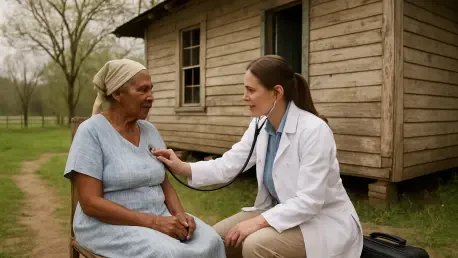In the heart of rural America, where hospital closures have left entire communities without emergency care, a staggering crisis unfolds as over 150 facilities have shuttered their doors since tracking began, compounded by a projected $137 billion reduction in federal healthcare spending over the next decade. This alarming trend has pushed states into a desperate race for survival. A newly established $50 billion federal fund promises a lifeline, but with strings attached, it demands innovation in a landscape already battered by financial strain. What does this mean for the millions of Americans living far from urban medical hubs, and can this fund truly transform a crumbling system?
The Urgent Fight for Rural Healthcare’s Future
The significance of this battle cannot be overstated, as rural healthcare teeters on the brink of collapse under the weight of looming Medicaid cuts. This $50 billion Rural Health Transformation Program, rolled out as a critical response, is not just about funding—it’s about reimagining how care reaches remote areas. With applications due by November 5 and awards set for year’s end, states are scrambling to secure their share, knowing that failure could mean the loss of essential services for vulnerable populations. The stakes are personal for countless families who rely on these hospitals for everything from childbirth to life-saving trauma care.
Beyond the numbers, the human toll is evident in places like Montana, where residents often drive hours for basic medical attention. The fund, introduced to offset the harsh impact of federal policy shifts, has ignited fierce competition among states, each vying to prove their proposals align with transformative goals. This moment represents a pivotal test of whether federal intervention can address deep-rooted disparities or if it will merely delay an inevitable decline in rural health access.
Why Rural Hospitals Are Crumbling Under Pressure
The crisis gripping rural healthcare stems from a perfect storm of financial and systemic challenges. With Medicaid cuts on the horizon under current federal legislation, rural hospitals—already operating on razor-thin margins—face an existential threat. Data from research centers tracking closures reveal a grim reality: these facilities often serve as the only healthcare option for miles, and their loss creates medical deserts where timely care becomes a distant dream. The strain is particularly acute in regions with aging populations and high poverty rates, amplifying the urgency for intervention.
Policy shifts at the federal level have only deepened the wound, as reduced reimbursements and shifting priorities leave rural providers struggling to keep their doors open. Unlike urban centers with multiple care options, rural communities lack the infrastructure to absorb such shocks. This backdrop of vulnerability explains why the $50 billion fund is seen as a critical juncture, not just for funding but for rethinking how healthcare can be sustained in areas where traditional models are failing.
Decoding the $50B Fund: A Clash of Vision and Reality
At its core, the Rural Health Transformation Program is designed to provoke systemic change rather than offer a quick financial fix. According to CMS innovation director Abe Sutton, the goal is to “rebuild and reshape” healthcare delivery, focusing on long-term solutions over temporary budget patches. This vision prioritizes innovation, pushing states to explore new models of care that could redefine access in remote regions. However, the ambitious scope of this mandate has sparked intense debate about what transformation should look like.
The fund’s structure adds another layer of complexity, with $25 billion allocated equally among approved states and the remaining half distributed based on rurality and alignment with policy goals like remote care and data infrastructure. Traditional providers, supported by groups like the National Rural Health Association, argue for investments in existing infrastructure to prevent further closures. Meanwhile, tech-driven startups such as Homeward Health advocate for AI and telehealth solutions, creating a rift between stabilizing the old and betting on the new in environments with scarce resources.
This tension raises critical questions about fairness and feasibility, especially in politically divided states where alignment with federal priorities could influence outcomes. The allocation process has drawn scrutiny, as smaller or less resourced states worry they might be sidelined despite their acute needs. As proposals take shape, the balance between innovation and immediate stability remains a central point of contention, with no easy answers in sight.
Hearing from the Ground: Diverse Voices in the Struggle
Across the spectrum of stakeholders, opinions on the fund vary widely, reflecting the complexity of the crisis. CMS leaders, including Administrator Mehmet Oz, emphasize the need for bold reinvention, urging states to move beyond outdated models. At a recent summit in Washington, D.C., Abe Sutton reiterated that past payment reforms have failed, signaling a firm push toward uncharted solutions. Their stance frames the fund as a catalyst for a broader overhaul, even if it risks alienating those seeking simpler relief.
Rural hospital advocates, like Brock Slabach of the National Rural Health Association, counter with a call for practicality, warning against overemphasis on flashy tech at the expense of immediate support. Hospital CEOs, such as David Mark of One Health in Montana, express skepticism about the fund’s impact, questioning whether a minimum of $100 million annually per state can truly reshape broken systems. Meanwhile, tech innovators like Jennifer Schneider of Homeward Health champion digital tools as the path forward, arguing that remote care can bridge gaps where physical infrastructure falls short.
The competitive undercurrent is palpable, with state advisers exchanging barbs over proposal strengths at industry gatherings. Political concerns also loom large, as Republican lawmakers voice fears that distribution might favor certain regions over others due to state-level differences. These diverse perspectives underscore a shared recognition of the crisis but reveal a fractured vision for how to address it, leaving rural communities caught in the crossfire of ideology and innovation.
Strategies for Success in a Cutthroat Competition
As the deadline for applications approaches, states and providers are honing strategies to stand out in a crowded field. Crafting winning proposals means aligning with CMS priorities—emphasizing remote care, advanced data systems, and consumer technologies—while demonstrating tangible impact for rural populations. Experts suggest that specificity is key, as vague promises of change are unlikely to secure approval in a process that values measurable outcomes.
Collaboration emerges as another vital tactic, with successful states likely to be those that forge partnerships between local providers, community organizations, and private tech firms. Such alliances can create comprehensive plans that blend innovation with on-the-ground realities, addressing both federal mandates and local needs. Engaging communities directly also plays a crucial role, ensuring that proposals reflect authentic challenges rather than top-down assumptions, which can boost credibility during evaluations.
Finally, anticipating pitfalls is essential, as political bias in allocation remains a concern for many. States must prepare for the possibility of receiving only a fraction of requested funds by focusing on scalable projects that deliver early results. With annual reevaluations tied to progress, flexibility and clear metrics will determine which regions sustain funding over time. These strategies offer a roadmap for navigating a high-stakes process where rural voices must fight to be heard amid the clamor for transformation.
Reflecting on a Defining Moment for Rural Health
Looking back, the scramble for the $50 billion Rural Health Transformation Program stood as a defining chapter in the struggle to save rural healthcare. It exposed the raw urgency of hospital closures and the devastating impact of federal spending cuts, while challenging states to rethink entrenched systems. The clash between traditional stability and cutting-edge innovation revealed deep divides, yet it also sparked vital conversations about equity and access in America’s most isolated regions.
As the dust settled on funding decisions, the path ahead demanded sustained collaboration among states, providers, and federal agencies to ensure that allocated resources translated into real change. Prioritizing transparent distribution and community-driven solutions became essential to avoid repeating past policy failures. This moment in history served as a reminder that rural healthcare’s survival hinged not just on money, but on a shared commitment to adapt and innovate in the face of overwhelming odds.









